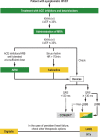The Treatment of Heart Failure with Reduced Ejection Fraction
- PMID: 32843138
- PMCID: PMC7643567
- DOI: 10.3238/arztebl.2020.0376
The Treatment of Heart Failure with Reduced Ejection Fraction
Abstract
Background: Chronic congestive heart failure is a common condition that, if untreated, markedly impairs the quality of life and is associated with a high risk of recurrent hospitalization and death.
Methods: This review is based on articles retrieved by a selective search in PubMed, as well as on relevant guidelines.
Results: Evidence-based treatment options are available only for congestive heart failure with a low ejection fraction. Pharma - cotherapy is based on neurohumoral inhibition of the renin-angiotensin-aldosterone system and the adrenergic system. The prognosis of patients with this condition has been further improved recently through the introduction of combined angiotensin receptor antagonists and neprilysin inhibitors. Modern implantable devices are a further component of treatment. Implantable defibrillators and special pacemakers for cardiac resynchronization are well established; the utility of alternative devices (baroreflex modulation or cardiac contractility modulation) needs to be investigated in further studies. It was recently shown that the catheter-based treatment of secondary mitral regurgitation with a MitraClip improves the outcome of selected patients.
Conclusion: The treatment of chronic systolic heart failure as recommended in the relevant guidelines, with drugs and implanted devices if indicated, can significantly improve the clinical outcome.
Figures


Comment in
-
Both Effects and Side Effects Must Be Taken Into Account.Dtsch Arztebl Int. 2021 Jan 11;118(1-2):11. doi: 10.3238/arztebl.m2021.0044. Dtsch Arztebl Int. 2021. PMID: 33750528 Free PMC article. No abstract available.
-
Additional Information Necessary.Dtsch Arztebl Int. 2021 Jan 11;118(1-2):11-12. doi: 10.3238/arztebl.m2021.0045. Dtsch Arztebl Int. 2021. PMID: 33750529 Free PMC article. No abstract available.
-
Non-Pharmacological Treatment Approaches.Dtsch Arztebl Int. 2021 Jan 11;118(1-2):12. doi: 10.3238/arztebl.m2021.0046. Dtsch Arztebl Int. 2021. PMID: 33750530 Free PMC article. No abstract available.
-
Treatment With Diuretics not Sufficiently Discussed.Dtsch Arztebl Int. 2021 Jan 11;118(1-2):12. doi: 10.3238/arztebl.m2021.0047. Dtsch Arztebl Int. 2021. PMID: 33750531 Free PMC article. No abstract available.
References
-
- Lindenfeld J, Albert NM, Boehmer JP, et al. HFSA 2010 Comprehensive heart failure practice guideline. J Card Fail. 2010;16 e1-194. - PubMed
-
- Ponikowski P, Voors AA, Anker SD, et al. 2016 ESC guidelines for the diagnosis and treatment of acute and chronic heart failure: The task force for the diagnosis and treatment of acute and chronic heart failure of the European Society of Cardiology (ESC) Developed with the special contribution of the Heart Failure Association (HFA) of the ESC. Eur J Heart Fail. 2016;18:891–975. - PubMed
-
- Maggioni AP, Dahlstrom U, Filippatos G, et al. EURObservational Research Programme: the Heart Failure Pilot Survey (ESC-HF Pilot) Eur J Heart Fail. 2010;12:1076–1084. - PubMed
-
- Seferovic PM, Ponikowski P, Anker SD, et al. Clinical practice update on heart failure 2019: pharmacotherapy, procedures, devices and patient management An expert consensus meeting report of The Heart Failure Association of the European Society of Cardiology. Eur J Heart Fail. 2019;21:1169–1186. - PubMed
Publication types
MeSH terms
LinkOut - more resources
Full Text Sources
Other Literature Sources
Medical

